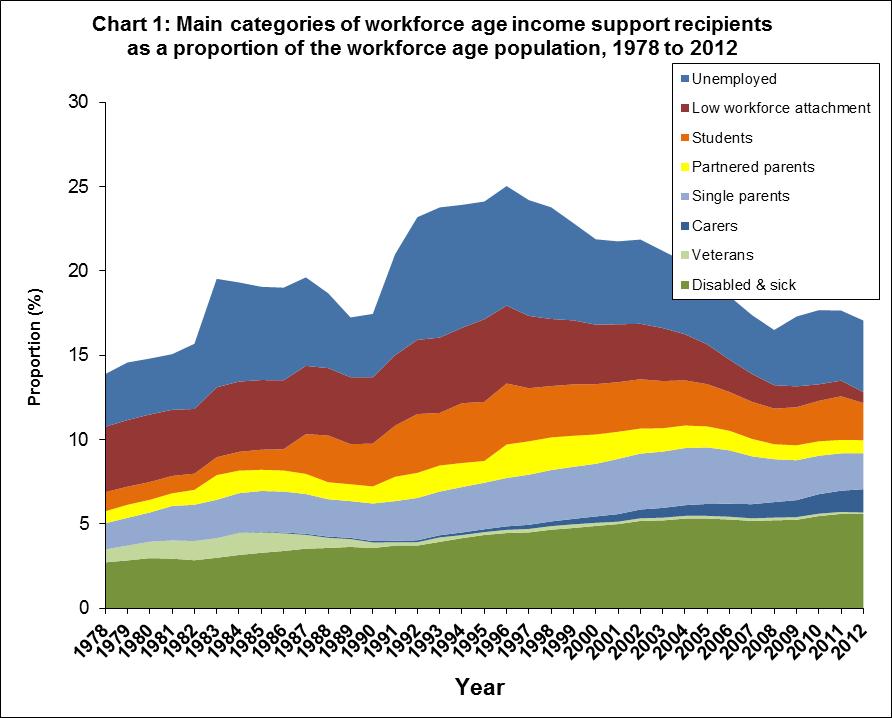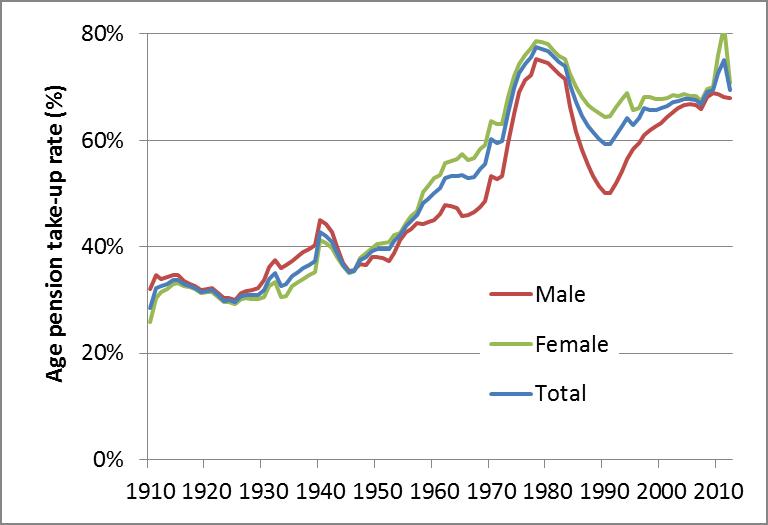Posted 24/01/2014 by Carol Ey
The Minister for Social Services, Kevin Andrews, has recently expressed concern at the continued growth in the number of people in receipt of income support payments, and suggested that the welfare system is unsustainable. He has therefore commissioned Patrick McClure to undertake a review of the welfare system. Mr McClure’s previous review led to the Welfare to Work changes in 2006. However a closer investigation of the figures, released by the Department of Social Security, suggests that welfare receipt among those of working age is already declining, and hence the scope to make further large reductions may be limited. However Age Pension take up rates continue to increase.
While the number of people receiving income support payments increased by 3.6 % from 2002 to 2012, this was considerably less than the 16.6% increase in the Australian population over the same period. In fact, the numbers grew for only three payments—Age Pension and Disability Support Pension (DSP), both of which grew by 25%, and Carer Payment, which more than doubled over this period.
The increase in DSP has been extensively analysed, but as research quoted in an earlier FlagPost found, this growth has been driven by an ageing population and the closure or restriction of some other income support payments (in particular the raising of the Age Pension age for women). In fact, the proportion of the population with a disability who are in receipt of some form of income support has fallen, however these recipients are now concentrated in the DSP numbers, whereas they were previously spread across a range of payments including Parenting Payments, Veterans’ payments and other non-activity tested payments, many of which have now been closed to new entrants.
The increase in Carer Payment numbers is likely to be the result of similar factors. For example, many of those who would previously have been eligible for Wife Pension because their spouse was on DSP would now be claiming Carer Payment.
Overall, as Chart 1 shows, the proportion of the working age population (those aged 15 to 64) in receipt of income support was only 17.1%, which, apart from 2007, where it fell to 16.5%, is the lowest level of receipt since 1982.

While improving economic conditions may see further reductions in those receiving unemployment benefits, a significant proportion of Newstart (NSA) recipients (the major payment for those looking for work) are women aged over 50, who will not easily be absorbed into the labour market.
The other way to address rising costs is to review the levels of payment. In particular, the move of recipients to DSP from payments such as Partner Allowance and Mature Age Allowance, which were paid at the NSA rate, and even Parenting Payment Single (which is paid at a rate between NSA and the Pension rate) has been a factor in driving up the cost of welfare provision, particularly following the formal linking of Pension indexation rates to the higher of wage and prices growth, introduced by the Howard Government in 1997, and the Rudd Government’s significant increase in Pension rates in 2010 following the Harmer Review.
At this stage, Minister Andrews has specifically excluded any consideration of changes to the Age Pension arrangements in his review of the welfare system, even though Age Pensioners represent more than 45% of income support recipients in 2012, and with numbers growing at a slightly faster rate than DSP. While most of this increase is being driven by the ageing of the population, income support receipt is also increasing among those over 65, as can be seen in Chart 2. This is despite the introduction of compulsory superannuation, and considerable tax expenditure on incentives for increased superannuation savings (costing an estimated $30 billion in 2011-12, compared to $34.8 billion spent on the Age Pension in the same year).
Chart 2: Proportion of those of Age Pension age receiving the Age Pension, 1910 to 2012

As noted in the Parliamentary Library Briefing Book article on retirement income policies, ‘[c]hanges in retirement income policies typically have long lead times, but potentially large impacts on Australia’s long-term fiscal position.’
If Mr Andrews is serious about reducing the welfare budget in the long term, he may have to reconsider changes to the Age Pension, perhaps along the lines suggested by the Henry Review regarding the means test.
As noted in the Parliamentary Library Briefing Book article on retirement income policies, ‘[c]hanges in retirement income policies typically have long lead times, but potentially large impacts on Australia’s long-term fiscal position.’
If Mr Andrews is serious about reducing the welfare budget in the long term, he may have to reconsider changes to the Age Pension, perhaps along the lines suggested by the Henry Review regarding the means test.